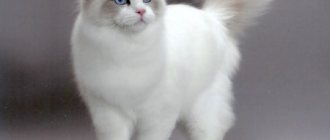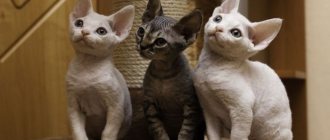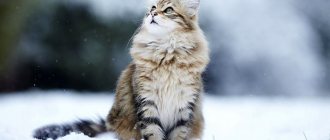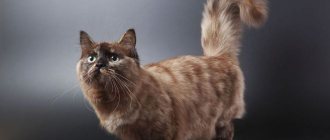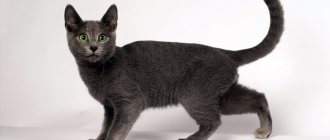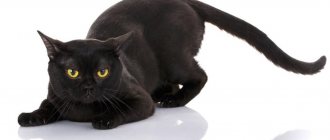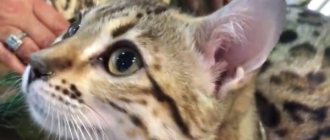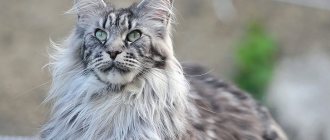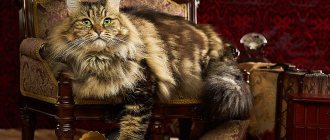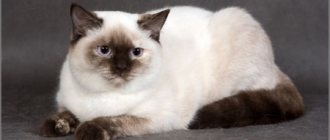Cats with short legs are actively winning the hearts of their owners.
It is believed that the ancestor of the first short-legged cats was the Blackberry cat. A Louisiana woman adopted a cat with unusually short legs. Soon the cat gave birth to kittens, among which there was one with the same paws as its mother. The kitten was named Toulouse. The mutation turned out to be persistent - after some time, there were many animals with short legs in the vicinity of the farm. This is how the Munchkin breed appeared. 1991 is the year of official recognition of this breed. For the first time in Russia, short-legged cats became widely known not so long ago, at the end of the last century. Munchkins owe their name to the dwarf people from the fairy tale “The Wizard of Oz.”
History of the breed
The origin story begins in England in 1930, when the first 4 generations of kittens were born. However, during World War II the new breed was lost.
The next mention of a Munchkin cat appeared in 1983. In the state of Louisiana, American resident Sandra found and began caring for the last representative of the munchkins at that time.
Sandra's cat, named Brambleclaw, gave a new beginning to the emergence of a species that was little known at that time. Soon the cats that had been forgotten became some of the most popular members of the family.
The species received official recognition in 1985 in the USA, where munchkins were introduced and registered as a revived breed.
In 1991, the Munchkin breed was officially announced in the Tica show.
The breed, called the Munchkin, got its name in honor of the small people of the same name from Frank Baum's book "The Land of Oz."
Description of the breed
The Munchkin is a breed of cat with short legs, pronounced Munchkin cat in English. The main characteristics of the individuals are squat, with very short straight legs and a long body, which distinguishes them from ordinary cats.
Representatives of the species have a wedge-shaped head, which is directly proportional to the body. In males, the head is more developed, which shows their superiority over females.
In addition to the structure of the head, the peculiarity of cats is the heaviness of the body. Males of the Munchkin cat breed differ from females in weight by 1-2 kilograms, reaching up to 4 kg, in contrast to the opposite sex, which has up to 3.5 kg. These pets can live up to 13 years, and in rare cases, up to 20.
Long-haired representatives have shiny fur with developed undercoat, which is present most of all on the legs, neck and tail. Shorthairs have a “plush” coat.
Appearance
The Munchkin and Dachshund breeds have the same genetic anomaly, which is well expressed in the structure of the body, expressed in direct proportion to the tail and body and the length of the paws.
Cats with short legs also differ:
- medium nose with a slightly noticeable deflection;
- strong neck;
- slightly visible forearms at the base of the forelimbs;
- a shaggy fluffy tail with a rounded tip - the difference between the long-haired individuals of this species;
- the eyes are shaped like a large walnut.
The eye color of these cats is rich, even in color and can easily differ from the color of the animal.
Munchkin fold
Representatives of this breed differ in ear set from the existing standard, but cannot be recognized as a separate species. This is due to the presence of a risk of gene mutation and, as a result, health problems.
The Fold Munchkin or, as breeders call it, Folmax, is similar in appearance to the Scottish Fold cat due to genetic abnormalities in the skeleton and ear structure.
Interesting! The long-haired, fluffy Munchkin with very short legs, despite genetic abnormalities, has become popular among experienced breeders seeking to obtain a variety of options when crossing this species with other individuals of the family.
What causes the appearance of short-legged cats?
The reason for the short legs is not due to the selection work of felinologists, but to an accidental genetic failure. Cats with short legs are born with the gene for achondroplasia (a combination of dwarfism with disproportionate development of the limbs). The important thing is that achondroplasia does not spread to the entire body, but only affects the formation of the limbs. The remaining bones and spine remain unaffected by the spontaneous genetic mutation. “Short Paws” are not prone to arthritis and have no problems with movement.
Numerous studies by felinologists have proven that genes affecting short legs do not cause any diseases.
Diseases of short-legged cats
The lifespan of short-legged cats is on average 13–16 years. The most well-known health problem in such pets is lordosis. This disease is an increased curvature of the spine, as a result of which the ridge descends and puts pressure on the internal organs. The main cause of lordosis is obesity and a sedentary lifestyle, so you need to try not to overfeed the animal and involve it in active games.
When mating short-legged cats with breeds that carry dominant genes (loose ears, lack of a tail), the babies may develop cardiopathy. In Europe, breeding animals with genetic abnormalities is prohibited.
Content Features
It should be taken into account that short-legged cats, due to their physiological capabilities, cannot jump and climb high. Therefore, before you bring a short pet into your home, you need to:
- prepare the room: remove fragile objects;
- hide dangling wires;
- remove poisonous and thorny plants.
Features of care
Short-legged cats are absolutely unpretentious in everyday life, so they do not require special care.
Dwarf cats are unpretentious in everyday life, so they do not require special care
Basic rules should be followed:
- comb the animal once a week (during the molting period - every day);
- bathe the cat once every 4–6 months (or when dirty);
- treat your eyes with a cotton swab every day;
- clean your ears with cotton swabs every 7–10 days;
- cut nails once every 14 days;
- treat the oral cavity with special preparations at least once a week;
- timely introduce a vitamin-mineral complex into the diet.
Breeding Features
Short-legged cats are divided into two types:
- standard - animals with short legs;
- non-standard - long-legged pets.
Non-standard animals inherit all breed qualities and actively participate in the inbreeding program. To improve the gene pool, mating of standard and non-standard individuals is allowed.
One litter can produce cats with both short and long legs.
Two long-legged parents will never produce short-legged kittens.
Character traits
The short-legged Munchkin cat has a friendly disposition and always finds a common language with other pets: the cat’s dogs will not see her as a rival.
The pet respects its owners and easily adapts to the mood. Strangers also quickly establish contact with the kitten after seeing its feline charm and kindness.
Walking around the room, they stomp their feet like hedgehogs, which also lifts the mood. The cheerful, playful, easy-going nature of the munchkin will not leave anyone indifferent.
These cats are curious and friendly, love to play and easily tolerate the “squeezing” of children, do not show aggression towards other pets, but can catch smaller animals: birds and rodents.
The presented description of the breed shows that understated Munchkin cats can easily make friends not only with an adult owner, but also with a child.
Cats with short legs
The most famous breeds of cats with short legs are Munchkin, Bambino, Napoleon, Lamkin, Kinkalow, Skookum. Each of them has its own characteristics of behavior and character. All animals have a friendly disposition and get along well with small children.
Bambino
Bambino cats
The breed arose as a result of crossing two other breeds: the Sphynx and the Munchkin. The first kitten from such parents appeared in 2005. He inherited two distinctive features from his dad and mom: short legs and lack of hair.
The cat has good physical characteristics, loves to frolic, is able to remember and perform simple tricks, and knows and loves its owner.
Separation from the owner negatively affects the bambino: the animals even refuse to eat. This factor must be taken into account when deciding to get a pet. Cats tolerate moving, travel, and new surroundings well and quickly adapt to new conditions.
The breed is expensive; the price of a hairless kitten starts from 35,000 rubles.
Napoleon
Cats of the Napoleon breed
Napoleon is the result of crossing a Munchkin with a Persian. In 2005, the International Cat Association recognized the new breed.
The cat has a round muzzle and large eyes, the muzzle is more like the muzzle of a fluffy Persian. The wool is very thick, its length and color can vary. Weight no more than 2 kg. Jumping and falling from heights are especially dangerous for Napoleons.
Pets are distinguished by their peaceful nature, are suitable for families where children are raised, and go into the arms of strangers.
The price of a kitten depends on the pedigree, color and length of the paws, ranging from 30,000 to 80,000 rubles.
Be sure to read:
Cornish Rex: description of the breed, appearance, habits, training, maintenance
Lamkin
Cat of the Lambkin breed
Lambkin, or Lambkin (English: Lambkin Dwarf cat) is a dwarf breed with curly hair, recently bred in the USA. The Lemkin breed has no official recognition. The parents of the first lambkins were the Munchkin and the Selkilk Rex.
There are several nurseries for breeding purebred cats, all located in the USA and New Zealand. According to the clubs, there are no lambkin breeders in Russia.
A special feature of the breed is its curly coat, the color can vary, there are no standards. In the litter there are kittens with straight hair or curly hair, but with long legs.
Cats are funny and playful. They get along with children. They love to move and can climb heights.
Kittens are sold for an average of 15,000 rubles. Often, non-standard kittens from a litter of purebred cats are usually passed off as lambkins. When contacting a specialized nursery, the price will be several times higher. This is a very rare breed.
Munchkin
Munchkin cat
At the end of the last century, a US resident, Sandra, took in a stray cat, deciding that her legs were short because of the harsh living conditions. But Ezhevichka (that’s what the cat was called) gave birth to the same short-legged offspring. The breed achieved official recognition in 1991. Until now, the breed standard has not been fixed, but the description that a purebred animal must correspond to exists. This breed is involved in the development of new dwarf cat breeds.
The main feature of the Munchkin is its paws - they are short and straight. The color can be different, as well as the length of the coat. Among the representatives of the breed there are lop-eared individuals.
Munchkins are friendly creatures and get along well with people. Due to their short legs, they do not jump well in height. They become strongly attached to their owners.
The price of munchkins varies from 5,000 to 35,000 rubles.
Kinkaloe
Kinkalow cat
The breed was bred in the USA by crossing a Machkin and a Curl. Kittens have short legs and curled ears. This breed is found mainly in America; it has not become widespread in Russia, although Kinkalows are officially recognized.
Be sure to read:
The Siamese cat is sociable, affectionate and trusting, loves physical contact
The breed also has a long tail. The animals have thick, shiny fur. Weight does not exceed 3 kg.
Cats become very attached to their owner and do not like to be left alone. They enjoy playing with children. Frisky and active animals.
The price is high due to the fact that the breed is rare - from 500 to 1000 euros. You can only buy it in the USA.
Skookum
Skookum cat
American citizen Roy Galusha developed a new dwarf breed by crossing a munchkin and a laper in 1996. Roy achieved official recognition of the breed 10 years later.
Outwardly, Skookum is similar to other cats of dwarf breeds, but the weight of the animal is larger: up to 4 kg. The coat is wavy, especially the fluffy collar area.
Skookums spend their time actively, love to play with their owners, but will not bother them. A distinctive feature is a quiet voice.
The price is high - from 800 to 3500 euros, it will not be possible to buy in Russia. Can be purchased in European countries.
Nutrition
The short-legged Munchkin needs only a healthy and proper diet. It is advisable to include in his diet:
- meat - most of the diet should be from this product;
- vegetables, fish, eggs and cereals should be given 1-2 times a week.
All products must be selected carefully and ensure that the prepared food is low-fat. Due to the fact that your pet loves to eat, it is necessary to follow a feeding schedule, taking into account how active it is and in what physical shape. If the cat is fat, you need to slow down the pace of feeding and ask a specialist for advice on proper care of the animal.
Care and hygiene
Munchkin cats are extremely clean and quickly learn to use the litter box. It is advisable for them to choose a toilet with high sides or a closed one. Caring for and maintaining a short cat is not particularly difficult. It is enough to wipe your ears with it a couple of times a month and regularly wipe your eyes. If you wish, you can trim your claws, but these pets rarely damage furniture; a scratching post is enough for them.
Short-haired cats need brushing once a week, and a little more often during shedding. Long-haired dogs will need to be brushed a couple of times a week and daily if they shed. It is worth noting that hairs are easily removed with a furminator.
For the safety of your pet, it is advisable to remove all potentially dangerous objects higher up.
What to feed a munchkin
The Munchkin cat is a big fan of food, so it often suffers from excess weight. The owner should monitor the calorie content and portion size. It is also important to remember that the breed needs predominantly protein foods. If an industrial type of food has been chosen, then preference should be given to specialized premium and super-premium food.
Natural nutrition should consist of lean meat, for example, veal, chicken, turkey. You can give rabbit meat, sometimes sea fish and eggs. All food should be given to the cat ready-made without salt. You can add a small amount of vegetables and cereals to your diet.
A kitten should eat at least 6 times a day; an adult cat needs 3 meals.
Health
Representatives of this breed are in good health, but despite their excellent physical condition, they are plagued by back problems: lordosis, a disease expressed in the deflection of the spine due to weak muscles.
In addition to changing the position of the spine, this disease affects the heart and lungs - death is possible. To keep your cat healthy, you need to take it to the veterinarian and get the necessary vaccinations to prevent diseases.
It is possible to crossbreed only long-haired and short-haired representatives of the species in order to exclude deaths during the birth of kittens, as well as the transmission of life-threatening diseases.
Kitten in the house
In order for a munchkin kitten to appear in a family, you need to think about where you can buy a pet. When choosing a place of purchase, you should pay attention to nurseries and what breeders of this breed will offer, since Munchkin kittens in such places of sale will already be litter box trained and with the necessary vaccinations.
If you are not satisfied with the prices of breeders or kennels, you can use other places, such as exhibitions or online advertisements, but remember that there is a risk of buying a false munchkin.
A munchkin costs from 3 to 20 thousand rubles. The cost mainly depends on the color and age of the individual.
Summarizing all of the above, we point out that when the choice of pets is made, it must be conscious and made with maximum responsibility.
Munchkin cat character
The munchkin cat has a wonderful character. They are very peaceful, intelligent, affectionate and sociable. The friendly and patient nature of the Munchkin cat makes them one of the best cat pets. The Munchkin cat breed is very inquisitive; these cats get along well even with children. The nature of the Munchkin cat is very calm, but if necessary, they can quite stand up for themselves.
Munchkins' short legs do not prevent them from running and jumping quickly. These are very funny, nimble and curious creatures. Munchkin cats are energetic, agile and fast. Munchkins run quite fast and stomp their short legs very funny. Munchkins cannot jump high, but they are very active, so they will always find an alternative option to climb higher.
Munchkin cats are amazing creatures that are full of warmth and tenderness towards people. Munchkins adapt very easily and quickly to the regime of their owners. These cats love to take part in family gatherings, household conversations and always sense a person’s mood. Munchkins treat guests with friendliness and interest. The munchkin cat's docile nature allows it to get along well with other animals in the house. These cats can walk on a leash and love to travel.
There is one small flaw in the munchkin cat's character. They love to take possession of various small things. If a munchkin lives in your house and some little thing is missing, look for it in your pet’s favorite secret corners. As for Munchkin kittens, you often have to look for them yourself. Kids are very curious and often find themselves in difficult situations, climbing into hard-to-reach places. This is especially true for various hills, which, having climbed, they cannot get down themselves.
